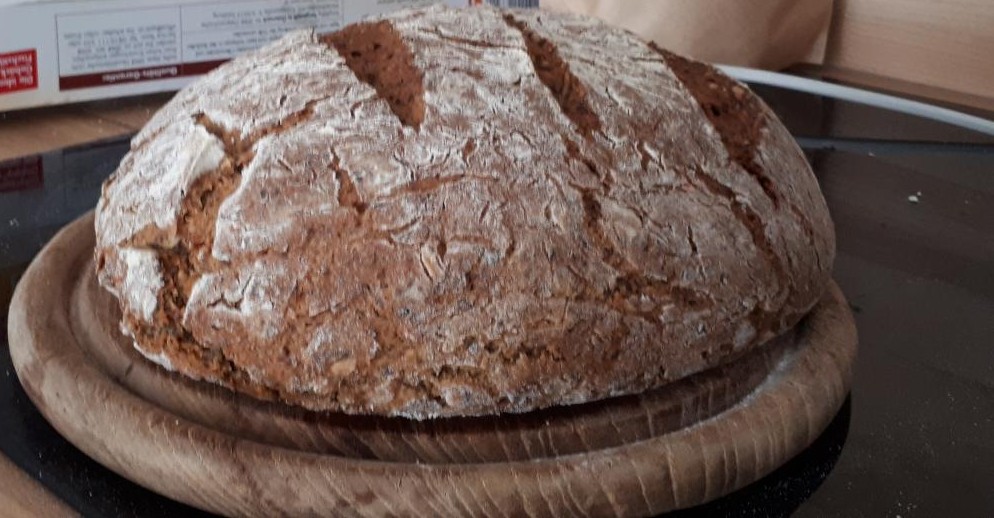Pupusa (from pipil pupusawa) is the Spanish pronunciation of popotlax, a conjugation of the words in the Nahuatl language; popotl meaning big, stuffed, bulging, and tlaxkalli or tortilla. It is a thick handmade corn tortilla (made using masa de maíz, a corn flour dough used in American cuisine that is filled with one or more of the following ingredients: cheese (usually a fresh cheese very common in certain American countries called quesillo), chicharrón, ayote, refried beans or cheese with loroco. There is also pupusa scrambled with mixed ingredients, such as cheese, beans, chicharrón or bacon.
Origin Nahuat was the language of the Pipils, a pre-Columbian settlement in the central and western part of El Salvador known as the Señorío de Cuzcatlán.
Fray Bernardino de Sahagún, was one of the religious who came to America; in one of his texts in 1570, he tells about the existence of a cooked dough meal, which was mixed with meat and beans. On the other hand, a publication of the National Museum of Anthropology Dr. David J. Guzmán affirms that pupusas were a fundamental part of the diet of pre-Columbian settlements in Ahuachapán, presumably Quichés who had migrated from Guatemala. At the beginning of the 19th century, Santiago I. Barberena on page 231 of his book "Quicheismo de folclore americano".
History
Pupusas are the most widespread typical food in El Salvador probably because of the tradition instituted from generation to generation. Although its origin is not known for certain, anthropological studies indicate that it was born in Central American territories, especially in western El Salvador.
-
Within the framework of the CAFTA negotiations, Honduran claims regarding the geographical origin of pupusas came to light, since in that country it is also a privileged dish, although not so popular.
-
The origin of the conflict, which involved more public opinion than the government, was the negotiation of products of origin; if El Salvador patented pupusas, it would be the only country that could export this product free of tariffs to the United States, which would give it a competitive advantage over the rest of the contracting countries of the agreement.
Ingredients
-
Dough: There are two types of dough, corn and rice. Rice pupusas originated in Olocuilta, and became popular in the 1980s when the highway leading to El Salvador's International Airport was built. Also popular in Nahuizalco are pupusas made of yucca dough.
-
Fillings: originally, in the 1930s-40s, they were filled with beans or cheese, and later, with chicharrón. Even so, pupusas are a recipe in constant change; the technique has been innovated and the ingredients have diversified. Common fillings today are: loroco flower, cochinito, or pitos, chipilín leaves or hierba mora, all of them aromatic plants from El Salvador, spinach, ayote, which is a variety of squash, ham, chicken or beef, fish, shrimp, mushrooms, garlic, jalapeño peppers, or even chorizo, pepperoni or salami. The fillings also depend on the region, as for example pupusa stuffed with papelillo is typical of the Oriente.
Pupusa is one of the symbols of Salvadoran culinary identity. It is consumed by all social classes throughout the country for breakfast, lunch or dinner. Going to a pupusería for dinner is a social act in this country. Each pupusa has an approximate nutritional value of 350 calories, so a couple of them constitute a meal time for an average person. In this sense, the Food and Agriculture Organization of the United Nations (FAO) considers that it is an essential part of the basic Salvadoran diet, being an adequate means of food because of its low cost. In 2004, within the framework of the "International Year of Rice", pupusas were recognized worldwide as a popular food.
On the other hand, considering that El Salvador is one of the Latin American countries that contributes most immigrants to the United States, it is logical to find pupusas outside the national borders. Immigrants take the dish as part of the effort to maintain the culture even outside the country, which is why they continue to prepare and consume pupusas.
Join our brand new comm !ttrpg@hexbear.net :d20-fuck-ya:
Resources for Organizing your workplace/community :sabo:
Resources for Palestine :palestine-heart:
Buy coffee and learn more about the Zapatistas in Chiapas here :EZLN:
Here are some resourses on Prison Abolition :brick-police:
Foundations of Leninism :USSR:
:lenin-shining: :unity: :kropotkin-shining:
Anarchism and Other Essays :ancom:
Remember, sort by new you :LIB:
Follow the Hexbear twitter account :comrade-birdie:
THEORY; it’s good for what ails you (all kinds of tendencies inside!) :RIchard-D-Wolff:
Come listen to music with your fellow Hexbears in Cy.tube :og-hex-bear:
Queer stuff? Come talk in the queer megathread! ! :sicko-queer:
Monthly Neurodiverse Megathread and Monthly ND Venting Thread :Care-Comrade:


If Marx was alive today, he would explain the law of negation of negation by using the example of bimbo -> himbo ->herbo